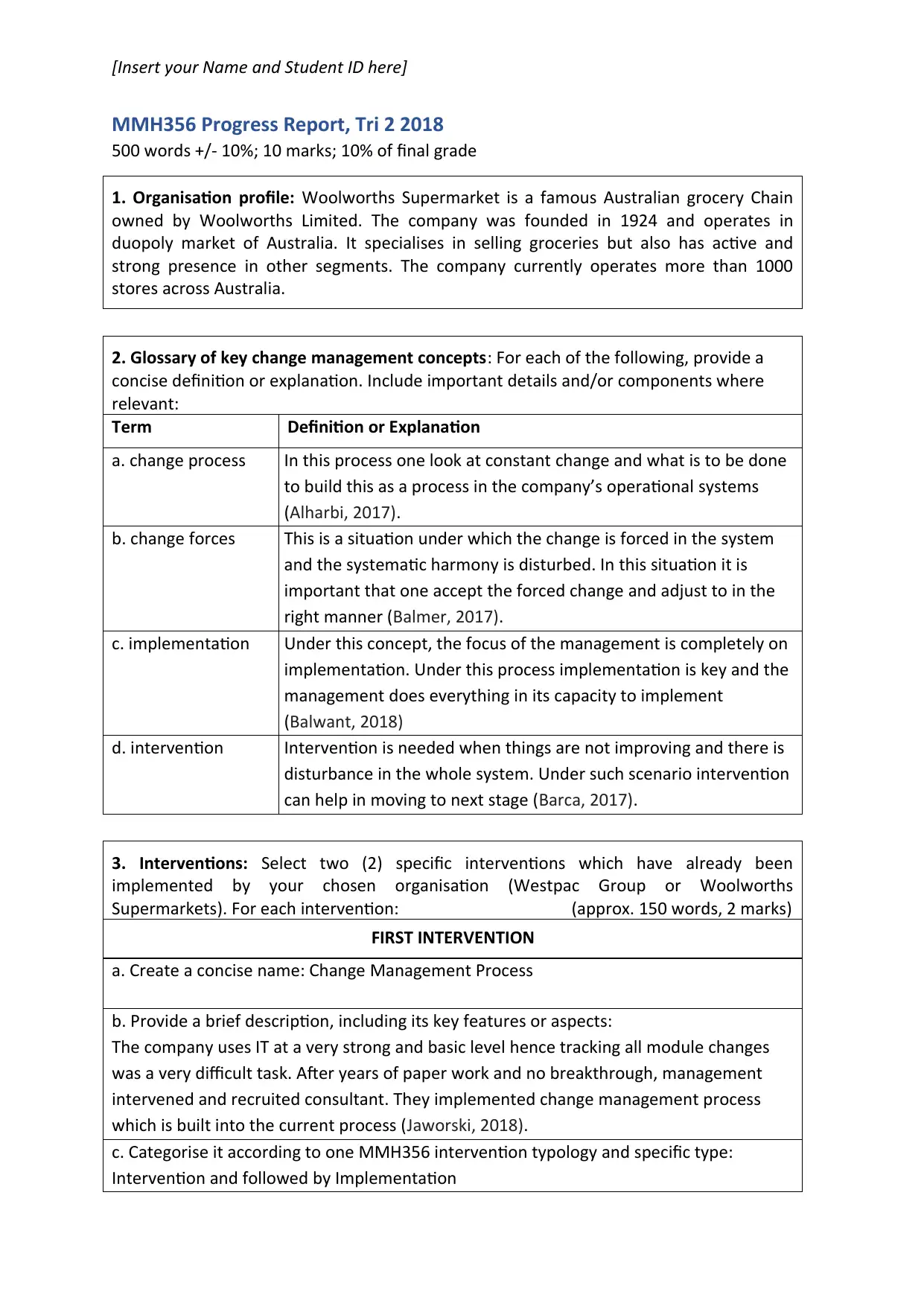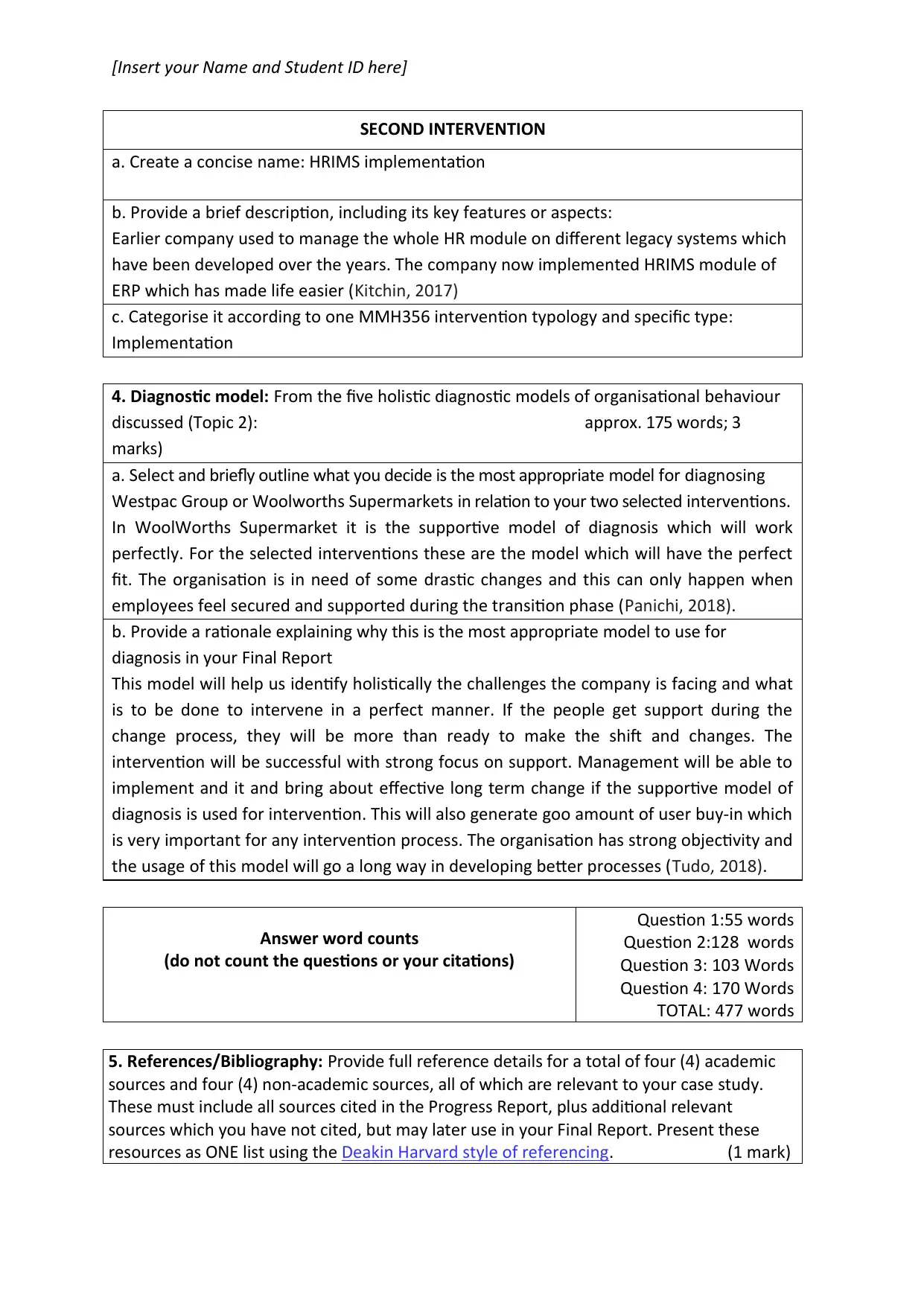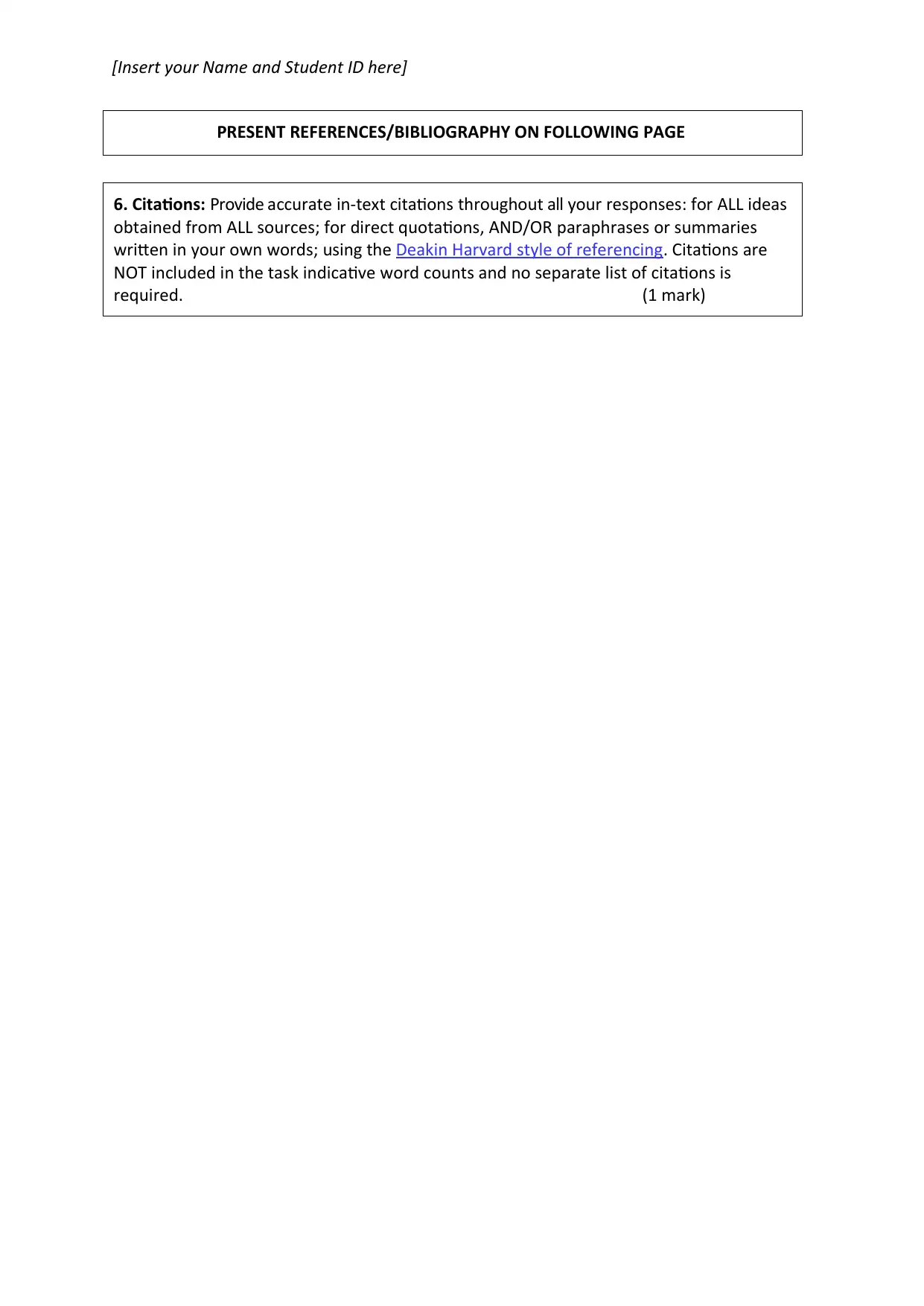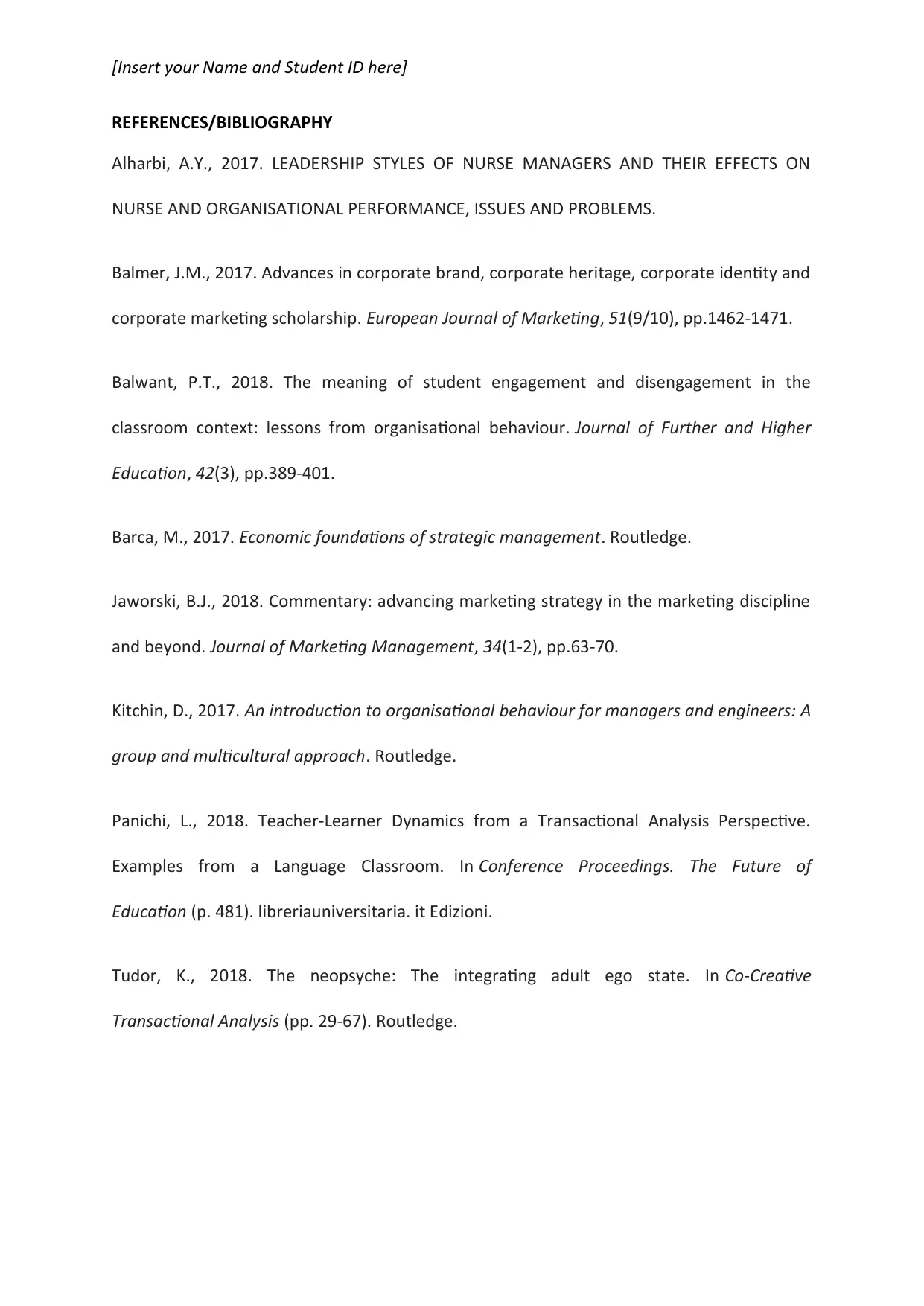Change Management Progress Report: Woolworths Supermarkets, 2018
VerifiedAdded on 2023/06/09
|4
|1209
|275
Report
AI Summary
This progress report provides an overview of Woolworths Supermarket's change management initiatives. It includes an organization profile, a glossary of key change management concepts (change process, change forces, implementation, and intervention), and an analysis of two specific interventions implemented by Woolworths: the implementation of a change management process and the implementation of a Human Resource Information Management System (HRIMS). Each intervention is described, named, and categorized according to an intervention typology. The report also identifies the supportive model of diagnosis as the most appropriate model for diagnosing Woolworths in relation to the selected interventions, providing a rationale for its selection based on the need for employee support during the transition phase to foster user buy-in and ensure the success of the interventions. The report concludes with a list of academic and non-academic references.

[Insert your Name and Student ID here]
MMH356 Progress Report, Tri 2 2018
500 words +/- 10%; 10 marks; 10% of final grade
1. Organisation profile: Woolworths Supermarket is a famous Australian grocery Chain
owned by Woolworths Limited. The company was founded in 1924 and operates in
duopoly market of Australia. It specialises in selling groceries but also has active and
strong presence in other segments. The company currently operates more than 1000
stores across Australia.
2. Glossary of key change management concepts: For each of the following, provide a
concise definition or explanation. Include important details and/or components where
relevant:
Term Definition or Explanation
a. change process In this process one look at constant change and what is to be done
to build this as a process in the company’s operational systems
(Alharbi, 2017).
b. change forces This is a situation under which the change is forced in the system
and the systematic harmony is disturbed. In this situation it is
important that one accept the forced change and adjust to in the
right manner (Balmer, 2017).
c. implementation Under this concept, the focus of the management is completely on
implementation. Under this process implementation is key and the
management does everything in its capacity to implement
(Balwant, 2018)
d. intervention Intervention is needed when things are not improving and there is
disturbance in the whole system. Under such scenario intervention
can help in moving to next stage (Barca, 2017).
3. Interventions: Select two (2) specific interventions which have already been
implemented by your chosen organisation (Westpac Group or Woolworths
Supermarkets). For each intervention: (approx. 150 words, 2 marks)
FIRST INTERVENTION
a. Create a concise name: Change Management Process
b. Provide a brief description, including its key features or aspects:
The company uses IT at a very strong and basic level hence tracking all module changes
was a very difficult task. After years of paper work and no breakthrough, management
intervened and recruited consultant. They implemented change management process
which is built into the current process (Jaworski, 2018).
c. Categorise it according to one MMH356 intervention typology and specific type:
Intervention and followed by Implementation
MMH356 Progress Report, Tri 2 2018
500 words +/- 10%; 10 marks; 10% of final grade
1. Organisation profile: Woolworths Supermarket is a famous Australian grocery Chain
owned by Woolworths Limited. The company was founded in 1924 and operates in
duopoly market of Australia. It specialises in selling groceries but also has active and
strong presence in other segments. The company currently operates more than 1000
stores across Australia.
2. Glossary of key change management concepts: For each of the following, provide a
concise definition or explanation. Include important details and/or components where
relevant:
Term Definition or Explanation
a. change process In this process one look at constant change and what is to be done
to build this as a process in the company’s operational systems
(Alharbi, 2017).
b. change forces This is a situation under which the change is forced in the system
and the systematic harmony is disturbed. In this situation it is
important that one accept the forced change and adjust to in the
right manner (Balmer, 2017).
c. implementation Under this concept, the focus of the management is completely on
implementation. Under this process implementation is key and the
management does everything in its capacity to implement
(Balwant, 2018)
d. intervention Intervention is needed when things are not improving and there is
disturbance in the whole system. Under such scenario intervention
can help in moving to next stage (Barca, 2017).
3. Interventions: Select two (2) specific interventions which have already been
implemented by your chosen organisation (Westpac Group or Woolworths
Supermarkets). For each intervention: (approx. 150 words, 2 marks)
FIRST INTERVENTION
a. Create a concise name: Change Management Process
b. Provide a brief description, including its key features or aspects:
The company uses IT at a very strong and basic level hence tracking all module changes
was a very difficult task. After years of paper work and no breakthrough, management
intervened and recruited consultant. They implemented change management process
which is built into the current process (Jaworski, 2018).
c. Categorise it according to one MMH356 intervention typology and specific type:
Intervention and followed by Implementation
Paraphrase This Document
Need a fresh take? Get an instant paraphrase of this document with our AI Paraphraser

[Insert your Name and Student ID here]
SECOND INTERVENTION
a. Create a concise name: HRIMS implementation
b. Provide a brief description, including its key features or aspects:
Earlier company used to manage the whole HR module on different legacy systems which
have been developed over the years. The company now implemented HRIMS module of
ERP which has made life easier (Kitchin, 2017)
c. Categorise it according to one MMH356 intervention typology and specific type:
Implementation
4. Diagnostic model: From the five holistic diagnostic models of organisational behaviour
discussed (Topic 2): approx. 175 words; 3
marks)
a. Select and briefly outline what you decide is the most appropriate model for diagnosing
Westpac Group or Woolworths Supermarkets in relation to your two selected interventions.
In WoolWorths Supermarket it is the supportive model of diagnosis which will work
perfectly. For the selected interventions these are the model which will have the perfect
fit. The organisation is in need of some drastic changes and this can only happen when
employees feel secured and supported during the transition phase (Panichi, 2018).
b. Provide a rationale explaining why this is the most appropriate model to use for
diagnosis in your Final Report
This model will help us identify holistically the challenges the company is facing and what
is to be done to intervene in a perfect manner. If the people get support during the
change process, they will be more than ready to make the shift and changes. The
intervention will be successful with strong focus on support. Management will be able to
implement and it and bring about effective long term change if the supportive model of
diagnosis is used for intervention. This will also generate goo amount of user buy-in which
is very important for any intervention process. The organisation has strong objectivity and
the usage of this model will go a long way in developing better processes (Tudo, 2018).
Answer word counts
(do not count the questions or your citations)
Question 1:55 words
Question 2:128 words
Question 3: 103 Words
Question 4: 170 Words
TOTAL: 477 words
5. References/Bibliography: Provide full reference details for a total of four (4) academic
sources and four (4) non-academic sources, all of which are relevant to your case study.
These must include all sources cited in the Progress Report, plus additional relevant
sources which you have not cited, but may later use in your Final Report. Present these
resources as ONE list using the Deakin Harvard style of referencing. (1 mark)
SECOND INTERVENTION
a. Create a concise name: HRIMS implementation
b. Provide a brief description, including its key features or aspects:
Earlier company used to manage the whole HR module on different legacy systems which
have been developed over the years. The company now implemented HRIMS module of
ERP which has made life easier (Kitchin, 2017)
c. Categorise it according to one MMH356 intervention typology and specific type:
Implementation
4. Diagnostic model: From the five holistic diagnostic models of organisational behaviour
discussed (Topic 2): approx. 175 words; 3
marks)
a. Select and briefly outline what you decide is the most appropriate model for diagnosing
Westpac Group or Woolworths Supermarkets in relation to your two selected interventions.
In WoolWorths Supermarket it is the supportive model of diagnosis which will work
perfectly. For the selected interventions these are the model which will have the perfect
fit. The organisation is in need of some drastic changes and this can only happen when
employees feel secured and supported during the transition phase (Panichi, 2018).
b. Provide a rationale explaining why this is the most appropriate model to use for
diagnosis in your Final Report
This model will help us identify holistically the challenges the company is facing and what
is to be done to intervene in a perfect manner. If the people get support during the
change process, they will be more than ready to make the shift and changes. The
intervention will be successful with strong focus on support. Management will be able to
implement and it and bring about effective long term change if the supportive model of
diagnosis is used for intervention. This will also generate goo amount of user buy-in which
is very important for any intervention process. The organisation has strong objectivity and
the usage of this model will go a long way in developing better processes (Tudo, 2018).
Answer word counts
(do not count the questions or your citations)
Question 1:55 words
Question 2:128 words
Question 3: 103 Words
Question 4: 170 Words
TOTAL: 477 words
5. References/Bibliography: Provide full reference details for a total of four (4) academic
sources and four (4) non-academic sources, all of which are relevant to your case study.
These must include all sources cited in the Progress Report, plus additional relevant
sources which you have not cited, but may later use in your Final Report. Present these
resources as ONE list using the Deakin Harvard style of referencing. (1 mark)

[Insert your Name and Student ID here]
PRESENT REFERENCES/BIBLIOGRAPHY ON FOLLOWING PAGE
6. Citations: Provide accurate in-text citations throughout all your responses: for ALL ideas
obtained from ALL sources; for direct quotations, AND/OR paraphrases or summaries
written in your own words; using the Deakin Harvard style of referencing. Citations are
NOT included in the task indicative word counts and no separate list of citations is
required. (1 mark)
PRESENT REFERENCES/BIBLIOGRAPHY ON FOLLOWING PAGE
6. Citations: Provide accurate in-text citations throughout all your responses: for ALL ideas
obtained from ALL sources; for direct quotations, AND/OR paraphrases or summaries
written in your own words; using the Deakin Harvard style of referencing. Citations are
NOT included in the task indicative word counts and no separate list of citations is
required. (1 mark)
⊘ This is a preview!⊘
Do you want full access?
Subscribe today to unlock all pages.

Trusted by 1+ million students worldwide

[Insert your Name and Student ID here]
REFERENCES/BIBLIOGRAPHY
Alharbi, A.Y., 2017. LEADERSHIP STYLES OF NURSE MANAGERS AND THEIR EFFECTS ON
NURSE AND ORGANISATIONAL PERFORMANCE, ISSUES AND PROBLEMS.
Balmer, J.M., 2017. Advances in corporate brand, corporate heritage, corporate identity and
corporate marketing scholarship. European Journal of Marketing, 51(9/10), pp.1462-1471.
Balwant, P.T., 2018. The meaning of student engagement and disengagement in the
classroom context: lessons from organisational behaviour. Journal of Further and Higher
Education, 42(3), pp.389-401.
Barca, M., 2017. Economic foundations of strategic management. Routledge.
Jaworski, B.J., 2018. Commentary: advancing marketing strategy in the marketing discipline
and beyond. Journal of Marketing Management, 34(1-2), pp.63-70.
Kitchin, D., 2017. An introduction to organisational behaviour for managers and engineers: A
group and multicultural approach. Routledge.
Panichi, L., 2018. Teacher-Learner Dynamics from a Transactional Analysis Perspective.
Examples from a Language Classroom. In Conference Proceedings. The Future of
Education (p. 481). libreriauniversitaria. it Edizioni.
Tudor, K., 2018. The neopsyche: The integrating adult ego state. In Co-Creative
Transactional Analysis (pp. 29-67). Routledge.
REFERENCES/BIBLIOGRAPHY
Alharbi, A.Y., 2017. LEADERSHIP STYLES OF NURSE MANAGERS AND THEIR EFFECTS ON
NURSE AND ORGANISATIONAL PERFORMANCE, ISSUES AND PROBLEMS.
Balmer, J.M., 2017. Advances in corporate brand, corporate heritage, corporate identity and
corporate marketing scholarship. European Journal of Marketing, 51(9/10), pp.1462-1471.
Balwant, P.T., 2018. The meaning of student engagement and disengagement in the
classroom context: lessons from organisational behaviour. Journal of Further and Higher
Education, 42(3), pp.389-401.
Barca, M., 2017. Economic foundations of strategic management. Routledge.
Jaworski, B.J., 2018. Commentary: advancing marketing strategy in the marketing discipline
and beyond. Journal of Marketing Management, 34(1-2), pp.63-70.
Kitchin, D., 2017. An introduction to organisational behaviour for managers and engineers: A
group and multicultural approach. Routledge.
Panichi, L., 2018. Teacher-Learner Dynamics from a Transactional Analysis Perspective.
Examples from a Language Classroom. In Conference Proceedings. The Future of
Education (p. 481). libreriauniversitaria. it Edizioni.
Tudor, K., 2018. The neopsyche: The integrating adult ego state. In Co-Creative
Transactional Analysis (pp. 29-67). Routledge.
1 out of 4
Related Documents
Your All-in-One AI-Powered Toolkit for Academic Success.
+13062052269
info@desklib.com
Available 24*7 on WhatsApp / Email
![[object Object]](/_next/static/media/star-bottom.7253800d.svg)
Unlock your academic potential
Copyright © 2020–2025 A2Z Services. All Rights Reserved. Developed and managed by ZUCOL.



